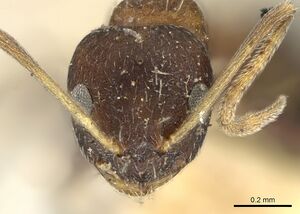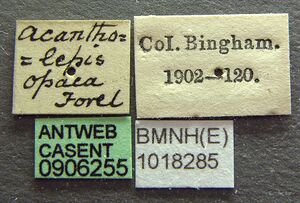Lepisiota opaca
| Lepisiota opaca | |
|---|---|

| |
| Scientific classification | |
| Kingdom: | Animalia |
| Phylum: | Arthropoda |
| Class: | Insecta |
| Order: | Hymenoptera |
| Family: | Formicidae |
| Subfamily: | Formicinae |
| Tribe: | Plagiolepidini |
| Genus: | Lepisiota |
| Species: | L. opaca |
| Binomial name | |
| Lepisiota opaca (Forel, 1892) | |
This is one of the widespread species of its genus and relatively common in India. The specimens were mainly collected by beating vegetation (Wachkoo et al., 2021). It has smaller-sized workers, which we have found dwelling on different plants or flowers. It is the smallest among all the Lepisiota species in our collection from Central India and it is not so frequent in collections (Harshana & Dey, 2022).
Identification
Lepisiota opaca is a medium-sized ant. It superficially resembles Lepisiota fergusoni and Lepisiota pulchella but can be separated from both by a smooth and shiny body, whereas L. fergusoni and L. pulchella have dull and coarsely sculptured bodies. (Wachkoo et al., 2021)
Lepisiota opaca distinctly differs from Lepisiota pusaensis (which has been possibly misidentified as L. opaca in Wachkoo et al. 2021) in the sculpture of the head and mesosoma. Head of L. pusaensis bears microreticulate sculpture and is shiny while L. opaca has reticulate-punctate sculpture on the head and its overall appearance is dull. Dorsum of pronotum is microreticulate in L. pusaensis, while L. opaca has reticulate-punctate sculpture (Forel 1892) (Harshana & Dey, 2022).
Keys including this Species
Distribution
China, India (Arunachal Pradesh, Assam, Himachal Pradesh, Goa, Jammu and Kashmir, Karnataka, Kerala, Madhya Pradesh, Maharashtra, Sikkim, West Bengal), Sri Lanka (Guénard & Dunn 2012; Bharti et al. 2016; Sheikh et al. 2019; Dias et al. 2020; Wachkoo et al. 2021).
Latitudinal Distribution Pattern
Latitudinal Range: 32.628611° to 12.938775°.
| North Temperate |
North Subtropical |
Tropical | South Subtropical |
South Temperate |
- Source: AntMaps
Distribution based on Regional Taxon Lists
Oriental Region: India (type locality), Sri Lanka.
Palaearctic Region: China.
Distribution based on AntMaps
Distribution based on AntWeb specimens
Check data from AntWeb
Countries Occupied
| Number of countries occupied by this species based on AntWiki Regional Taxon Lists. In general, fewer countries occupied indicates a narrower range, while more countries indicates a more widespread species. |

|
Estimated Abundance
| Relative abundance based on number of AntMaps records per species (this species within the purple bar). Fewer records (to the left) indicates a less abundant/encountered species while more records (to the right) indicates more abundant/encountered species. |

|
Biology
Castes
Images from AntWeb
   
| |
| Worker. Specimen code casent0906255. Photographer Estella Ortega, uploaded by California Academy of Sciences. | Owned by NHMUK, London, UK. |
 Harshana & Dey (2022), Figure 8A–F. Syntype worker (AntWeb: CASENT0909893, photographed by Zach Lieberman) of Lepisiota opaca (A–C), worker of Lepisiota pulchella (D–F). A, D, body in profile view; B, E, body in dorsal view; C, F, head in full-face view.
Harshana & Dey (2022), Figure 8A–F. Syntype worker (AntWeb: CASENT0909893, photographed by Zach Lieberman) of Lepisiota opaca (A–C), worker of Lepisiota pulchella (D–F). A, D, body in profile view; B, E, body in dorsal view; C, F, head in full-face view.
Nomenclature
The following information is derived from Barry Bolton's Online Catalogue of the Ants of the World.
- opaca. Acantholepis opaca Forel, 1892a: 43 (diagnosis in key) (w.) INDIA. Combination in Lepisiota: Xu, 1994c: 235. See also: Bingham, 1903: 318.
Description
Worker
Bingham (1903): Head reddish brown, mandibles and antennae pale testaceous, thorax and node of pedicel reddish yellow, legs testaceous shaded with fuscous, abdomen a beautiful purplish black. Head and thorax finely and very closely punctured, opaque: abdomen shining, with in certain lights a metallic tint. Head, thorax and abdomen covered with fairly abundant short semi-erect white hairs, and an extremely minute sericeous pubescence only seen in certain lights. Head without the mandibles nearly square, the occiput slightly flattened and transverse: mandibles rather large, acutely dentate; clypeus large and very convex, medially vertically carinate; antennae with the scape rather short, extending very little beyond the top of the head. Thorax: the pronotum broad, nearly as broad as the head, flat above, the mesonotum moderately constricted, the meso-metanotal suture deep and wide; the metanotum short, its sides forming lateral acute tubercles. Node of the pedicel proportionately somewhat thick and high, surmounted by two parallel acute spines on the lateral angles above; abdomen large and massive, slightly depressed and acutely pointed at apex.
Length: 2.2 - 2.5 mm
Wachkoo et al. (2021): Head subquadrate; slightly longer than wide, wider posteriorly than in front; lateral margins convex, posterior margin nearly transverse to convex, with rounded posterolateral corners; clypeus carinate in the middle; anterior clypeal margin complete and convex; eyes oval, weakly convex, placed at the middle-line of head, covering about one-third of lateral cephalic margin; three small ocelli present; antennal scape surpassing posterior head margin by about one-third its length. In lateral view promesonotum convex, metanotum low, almost straight; pronotum flat above; mesometanotum demarcated; metanotal area distinct; mesometanotum constricted; propodeum armed with a pair of posteriorly diverging, upward directed sharp spines; propodeal declivity steep. Petiole upright, with angular sides, dorsally emarginate, armed with a pair of almost straight spines pointing upward.
Overall body smooth and shiny; malar space usually coarsely microreticulate, remainder of head mostly shiny with effaced sculpture; pronotum smooth and shiny, remainder of mesosomal dorsal feebly microreticulate; propleuron smooth and shiny, rest of lateral mesosoma longitudinally striate; mesometanotal suture cross. Body abundantly covered with erect setae; pubescence very fine and sparse, least on mesosoma; antennal funiculus with subdecumbent to suberect pubescence. Head reddish-brown, mesosoma and petiole reddish-yellow, gaster purplish-black, some specimens with a light reddish-yellow patch anteriorly on first gastral tergite; antenna, mandible and legs reddish-brown
Measurements (n = 8): HL 0.63–0.70; HW 0.58– 0.65; EL 0.19–0.22; SL 0.64–0.76; PnW 0.42–0.47; ML 0.79–1.00; PFL 0.53–0.61; PFW 0.14–0.16 mm. Indices: CI 91–93; SI 111–120; REL 29–32.
References
- Bharti, H., Sharma, Y.P., Kaur, A. 2009. Seasonal patterns of ants (Hymenoptera: Formicidae) in Punjab Shivalik. Halteres 1: 36-47.
- Bingham, C. T. 1903. The fauna of British India, including Ceylon and Burma. Hymenoptera, Vol. II. Ants and Cuckoo-wasps. London: Taylor and Francis, 506 pp. (page 318, see also)
- Dias, R.K.S., Rajapaksa, R.P.K.C. 2017. Geographic records of subfamilies, genera and species of ants (Hymenoptera: Formicidae) in the four climatic zones of Sri Lanka: A review. Journal of Science of the University of Kelaniya Sri Lanka 11, 23-45. (doi:10.4038/josuk.v11i2.7999).
- Forel, A. 1892a. Notes myrmécologiques. Ann. Soc. Entomol. Belg. 36: 38-43 (page 43, (diagnosis in key) worker described)
- Harshana, A., Dey, D. 2022. Taxonomic studies on the ant genus Lepisiota Santschi 1926 (Hymenoptera: Formicidae: Formicinae) in India, with description of four new species. Oriental Insects 1–34 (doi:10.1080/00305316.2022.2125096).
- Liu, C., Fischer, G., Hita Garcia, F., Yamane, S., Liu, Q., Peng, Y.Q., Economo, E.P., Guénard, B., Pierce, N.E. 2020. Ants of the Hengduan Mountains: a new altitudinal survey and updated checklist for Yunnan Province highlight an understudied insect biodiversity hotspot. ZooKeys 978, 1–171 (doi:10.3897/zookeys.978.55767).
- Wachkoo, A.A., Bharti, H., Akbar, S.A. 2021. Taxonomic review of the ant genus Lepisiota Santschi, 1926 (Hymenoptera: Formicidae: Formicinae) from India. Bonn Zoological Bulletin 70(2): 227–245 (doi:10.20363/BZB-2021.70.2.227).
- Xu, Z. 1994c. A taxonomic study of the ant genus Lepisiota Santschi from southwestern China (Hymenoptera Formicidae Formicinae). J. Southwest For. Coll. 14: 232-237 (page 235, Combination in Lepisiota)
References based on Global Ant Biodiversity Informatics
- Bharti H., Y. P. Sharma, M. Bharti, and M. Pfeiffer. 2013. Ant species richness, endemicity and functional groups, along an elevational gradient in the Himalayas. Asian Myrmecology 5: 79-101.
- Dad J. M., S. A. Akbar, H. Bharti, and A. A. Wachkoo. 2019. Community structure and ant species diversity across select sites ofWestern Ghats, India. Acta Ecologica Sinica 39: 219–228.
- Dias R. K. S., K. R. K. A. Kosgamage, and H. A. W. S. Peiris. 2012. The Taxonomy and Conservation Status of Ants (Order: Hymenoptera, Family: Formicidae) in Sri Lanka. In: The National Red List 2012 of Sri Lanka; Conservation Status of the Fauna and Flora. Weerakoon, D.K. & S. Wijesundara Eds., Ministry of Environment, Colombo, Sri Lanka. p11-19.
- Guénard B., and R. R. Dunn. 2012. A checklist of the ants of China. Zootaxa 3558: 1-77.
- Karmaly K. A.; S. Sumesh, T. P. Rabeesh, and L. Kishore. 2010. A checklist of ants of Thirunelli in Wayanad, Kerala. J. of the Bombay Natural History Society 107(1): 64-67.
- Li Z.h. 2006. List of Chinese Insects. Volume 4. Sun Yat-sen University Press
- Narendra A., H. Gibb, and T. M. Ali. 2011. Structure of ant assemblages in Western Ghats, India: role of habitat, disturbance and introduced species. Insect Conservation and diversity 4(2): 132-141.
- Rajan P. D., M. Zacharias, and T. M. Mustak Ali. 2006. Insecta: Hymenoptera: Formicidae. Fauna of Biligiri Rangaswamy Temple Wildlife Sanctuary (Karnataka). Conservation Area Series, Zool. Surv. India.i-iv,27: 153-188.
- Ran H., and S. Y. Zhou. 2012. Checklist of chinese ants: formicomorph subfamilies (Hymenoptera: Formicidae) II. Journal of Guangxi Normal University: Natural Science Edition 30(4): 81-91.
- Savitha S., N. Barve, and P. Davidar. 2008. Response of ants to disturbance gradients in and around Bangalore, India. Tropical Ecology 49(2): 235-243.
- Sheikh A. H., M. Manzoor, Y. A. Rather, and T. Jobiraj. 2019. Taxonomic study of ant (Formicidae : Hymenoptera) fauna of Dumna Nature Park, Jabalpur, Madhya Pradesh, India. Journal of Entomological Research 43(2): 203-212.
- Skarbek C. J., M. Noack, H. Bruelheide, W. Hardtle, G. von Oheimb, T. Scholten, S. Seitz, M. Staab. 2019. A tale of scale: plot but not neighbourhood tree diversity increases leaf litter ant diversity. Journal of Animal Ecology DOI: 10.1111/1365-2656.13115
- Staab M., J. Methorst, J. Peters, N. Bluthgen, and A. M. Klein. 2017. Tree diversity and nectar composition affect arthropod visitors on extrafloral nectaries in a diversity experiment. Journal of Plant Ecology 10(1): 210-212.
- Xu Z. 1998. A report of fourty-one ant species newly recorded in China from Xishuangbanna District of Yunnan Province (Hymenoptera: Formicidae). Zhongguo Xue Shu Qi Kan Wen Zhai 4: 1119-1121.

